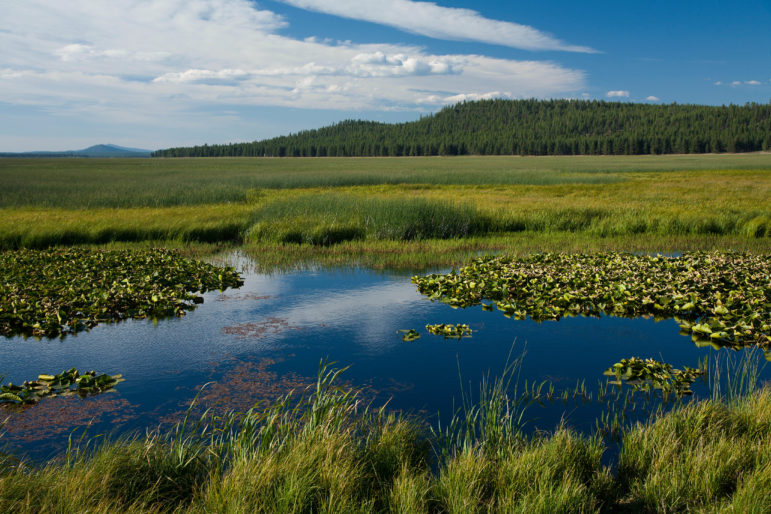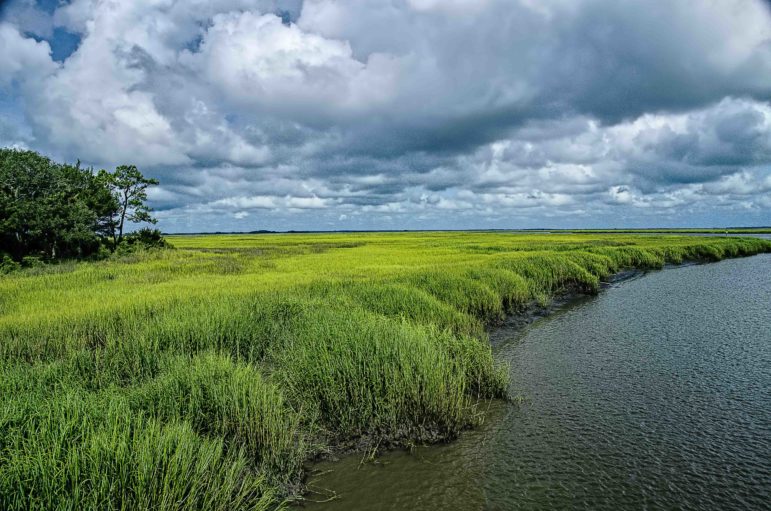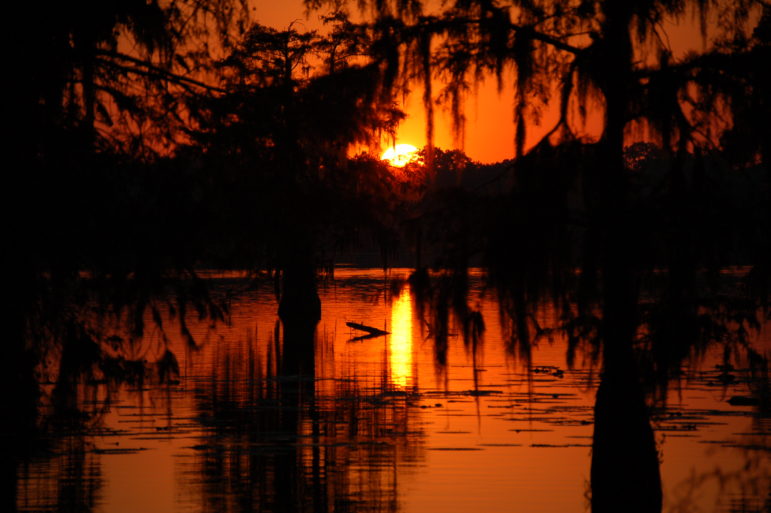TWH – May is American Wetlands Month as declared by the U.S. Environmental Protection Agency (EPA). The month, says the EPA, is a celebration of the “vital importance of wetlands to the Nation’s ecological, economic, and social health.”
The EPA’s partners in the event include the U.S. Department of Interior, the U.S. Department of Commerce, and the National Park Service.

Lilypads and Grasses at Klamath Marsh National Wildlife Refuge on the Fremont-Winema National Forest in Southern Oregon. Image credit: U.S. Forest Service – Pacific Northwest Region – Public Domain
The EPA notes that, “American Wetlands Month was begun in 1991 by EPA and its partners in federal, state, tribal, and local governments, and private and nonprofit organizations, as a way to educate Americans about the functions and values of wetlands.”
Wetlands are natural areas where water covers the soil or is present either at or near the surface of the soil all year or for varying periods during a year. The water saturation, or hydrology, determines the types of plants and animal communities that will be present in the area, living around, on, and even within the soil. Wetlands support both aquatic and terrestrial species.
There are two categories of wetlands: Costal/Tidal and Inland/non-tidal. Coastal/Tidal wetlands are found along ocean coasts of the Atlantic and Pacific oceans including the Gulf of Mexico and Alaskan waters. They are very tightly linked to the estuary system where seawater and freshwater mix. These types of wetlands vary greatly from the mangrove swamps of Florida to the salt marshes of New England as well as mud and sand flats. They are among the most productive ecosystem on the planet.

Salt marshes at Little St. Simon’s Island, Georgia (2015) – Image credit: Trish Hartmann – CC BY 2.0
The National Park Service notes, “Salt marshes are among the most productive ecosystems in the world, and are home to a wide variety of animals like oysters, crabs, shrimp, fish, birds and mammals. They are especially important as nursery areas for the larval and juvenile stages of many fish and shellfish species that spend their adult lives in more open estuary or ocean environments.”
They also limit the effect of storm surges, protecting barrier islands and coastal plains from erosion.
Inland/non-tidal wetlands are floodplains, isolated depressions, the margins of lakes, and other low-lying areas that accumulate water. They include wet meadows, bogs, fens, and swamps but also areas around the Great Lakes. Freshwater marshes are one of the most productive ecosystems on earth because of their accumulation of nutrients.
Beyond their impact on plant and animal communities, wetlands might also slow climate change. Researchers at the Salk Institute’s Harnessing Plants Initiative told KBPS that plant growth in wetlands can help mitigate the worst impacts of climate change.
“Plants are naturally carbon accumulating machines, right… They suck carbon dioxide out of the air,” said one of the researchers working an area near San Diego.

Louisiana Sunset (2010) – Image credit: jc.winkler – CC BY 2.0
The National Oceanic and Atmospheric Administration (NOAA) Fisheries, the US government’s authority on the science and management of fish, other marine life, and their habitats, added that wetlands support not only fish population, opportunities for recreation, and offer flood and coastal protection, but also help purify freshwater and support energy productions.
NOAA Fisheries said, “Eighteen percent of U.S. oil production and almost 25 percent of U.S. natural gas production originates in, is transported through, or is processed in Louisiana coastal wetlands. If you drive a car, cook, or heat your home, you might be using oil or gas that traveled through coastal wetlands.”
But wetlands are also under tremendous strain and threat. TennGreen Land Conservancy, a Tennessee nonprofit organization working to promote conservation and restoration of the natural world by acquiring and preserving land, wrote “Unfortunately, like in many states, wetlands have a long history of being damaged… As wetlands are destroyed, an ecosystem’s hydrologic (e.g., water) function is also lost. These lost wetland functions result in an increased frequency of flooding, higher levels of sedimentation, and reduction of vital habitat. By 1984, more than half of all wetlands in the United States had been lost to development and agriculture.”
A subsequent study in 2009 by U.S Fish and Wildlife found that “coastal watersheds of the lower 48 states lose 80,000 acres of coastal wetlands each year to erosion, subsidence, sea-level rise, development, and drainage. That’s approximately seven football fields every hour, and a 25 percent increase over the previous 6-year study period.”
Human activity has increased pollution and the allure of living near the coast has played a role in the degradation and destruction of many wetlands across the United States but notably in Florida.
But other parts of the US are also under threat even without immediate human activity. Alaska Public Media reported that an environmental case before the U.S. Supreme Court may determine the future of isolated wetlands throughout Alaska including the Yukon-Kuskokwim Delta. The EPA claims jurisdiction over isolated wetlands including areas that are dry during certain times of the year, per the definition of wetlands.
The State of Alaska, on the other hand, is asking for the court to narrow the EPA’s authority from the Clean Water Act. Alaska argues that permafrost wetlands do not fall under the EPA because they are frozen.

Aerial view of wetlands along the Kobuk River – National Park Service, Alaska Region – Image credit: Neal Herbert NPS – Public Domain
Alaska is not alone, either, 26 other states with mostly Republican leadership, are also asking the U.S. Supreme Court to end the federal Clean Water Act protection of isolated wetlands. A decision is expected in June 2022.
Besides learning about wetlands and their importance, NOAA Fisheries offers some ways to support Wetlands as part of the month-long celebration of the ecosystem:
- Respect natural areas. Enjoy scenic and recreational access to coastal wetlands, while preserving their integrity for future generations. Observe park trail and trash rules.
- Reduce, reuse, and recycle. One of the easiest ways to help the environment and reduce trash is to follow the 3 R’s every day. Bring a reusable bag or use a reusable water bottle. Compost. Donate clothes instead of throwing them away.
- Reduce polluted runoff. Install rain barrels. Reduce paved surfaces. Keep sidewalks, lawns, and driveways clear of pet waste, trash, toxic chemicals, fertilizers, and motor oil, all of which can wash into storm drains and end up in wetlands.
- Be smart about lawn and garden fertilizer. Use non-nitrogen lawn supplements to avoid nutrient pollution. Excess nutrients promote algae growth, which creates aquatic “dead zones” and can be toxic to humans.
- Use non-toxic products. Never spray lawn and garden chemicals outside on a windy day or when rain could wash the chemicals into waterways.
- Choose native plants. Opt for native species when planting trees, shrubs and flowers, including wetland native plants where appropriate.
- Protect wetland habitat. Do not fill wetlands when building a new home or developing a property. Use “living shoreline” techniques rather than concrete structures on waterfront property, making use of plant roots to stabilize soil.
The U.S. Fish and Wildlife Service offers the Wetlands Mapper tool on its National Wetlands Inventory that provides a variety of resources for understanding and conserving wetlands throughout the U.S.
The Wild Hunt is not responsible for links to external content.
To join a conversation on this post:
Visit our The Wild Hunt subreddit! Point your favorite browser to https://www.reddit.com/r/The_Wild_Hunt_News/, then click “JOIN”. Make sure to click the bell, too, to be notified of new articles posted to our subreddit.
